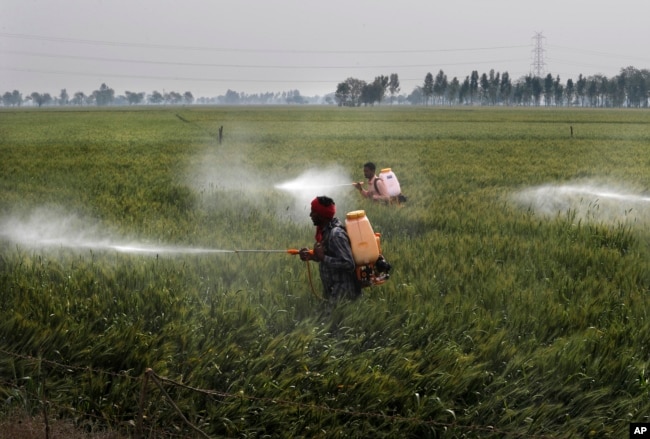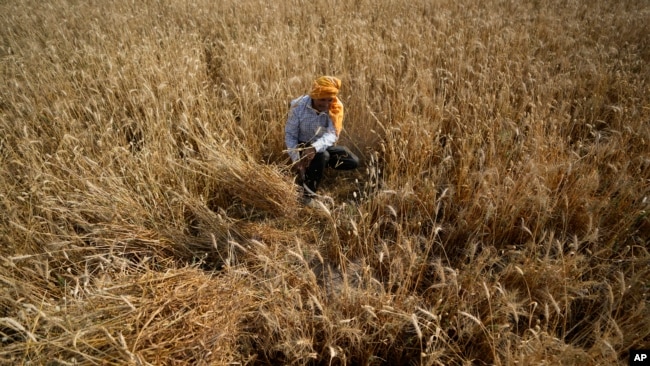近所のスーパー、デパート、軒並み小麦関連の商品が20%値上がりしました。
さらに値上がりするのでしょうね!!
ガソリンに電気・ガス料金も値上がりし。。。
今日もVOAで英語を学びましょう!!
インドの熱波が小麦の収穫に影響(和訳)
India’s Heat Wave Affects Wheat Crop
May 03,2022
インドでは異常に早い猛暑のため、小麦の収穫量が減少しているようなのです。そのため、ロシアのウクライナ戦争による不足分を補うために作物の輸出を増やす一方で、自国の需要を満たすことができるのか疑問視されています。
最近、インドの首都ニューデリー近郊で、廃棄物の貯蔵に使われている広大な土地がいくつか火災に見舞われました。火災は暑さのせいとされています。インド東部の学校は暑さのために閉鎖されました。インド中部のラージガル市では、気温が過去最高の46.5.℃に達しました。他の9つの都市でも気温は45℃に達しました。
しかし、農作物に打撃を与えたのは3月の暑さででした。小麦は暑さの影響を受けやすいのです。インドの農家は、小麦がインドの涼しい春に熟すように作付けのタイミングを計っています。
しかし、気候変動がインドの気温を上昇させた、とフリーデリケ・オットー氏は言います。彼女はロンドン大学インペリアルカレッジの気候科学者です。人間活動が世界の気温を上げる以前は、今年のような熱波は50年に一度インドを襲っただろう、と彼女は言います。
「しかし、現在では、このような高温は4年に1回程度と予想され、より一般的な現象となっています。」と彼女は言います。
インドの猛暑に対する脆弱性は、1990年から2019年にかけて15%増加しました。この情報は、イギリスの医学誌 Lancet が2021年に発表した報告書によるものです。
インドは、高齢者や貧困層などの弱者が暑さにさらされる割合が高い国のトップ5に入ります。インドとブラジルは、暑さによる死亡者数が世界で最も多い国であるとのことです。
バルデフ・シンさんのような農場労働者は、最も脆弱な人々の一人です。シンさんはインド北部のパンジャブ州で農業を営んでいます。いつもは涼しい春が猛暑に変わり、目の前で作物が干からびていくのを見たのです。作物の5分の1が失われました。
「最悪の事態がまだ続くのではないかと心配しています。」と彼は言います。
パンジャブ州は通常、インドの国家備蓄作物の最大の供給地です。政府はこの地域から今年の生産量の3分の1程度を購入することを期待していました。しかし、政府関係者は今年の生産量は少なくなると予測しています。農業政策の専門家であるデビンダー・シャルマ氏は、小麦の入手量が25%少なくなると予想していると言います。
ウッタル・プラデーシュ州やマディヤ・プラデーシュ州など、他の主要な小麦生産州でも同じことが言えます。
インド政府は2021年に4300万トン以上の小麦を購入しました。シャルマ氏は、代わりに20~50%少なく手に入ると見積もっています。
インドは世界第2位の小麦の生産国です。しかし、同国が輸出するのは収穫量のごく一部に過ぎません。インドは、ロシアのウクライナ戦争によって世界的に小麦の供給が途絶えたことで、利益を得ることを望んでいました。また、ヨーロッパ、アフリカ、アジアにインドの小麦の新市場を開拓したいとも考えています。
インドは、通常8000万人以上を養う大規模な食糧福祉計画のために、約2500万トンの小麦を必要としています。
コロナウイルスが発生する前、インドは必要量をはるかに超える供給量を持っていました。しかし、シャーマ氏によれば、その備蓄は食糧福祉プログラムによって圧迫されたとのことです。当局はパンデミックの間、約8億人の人々に無料で穀物を提供しました。
このプログラムは9月まで延長されました。しかし、このプログラムがそれ以降も継続されるかどうかは不明です。
India’s Heat Wave Affects Wheat Crop
An unusually early heat wave in India has likely reduced the country’s wheat harvest. That has left observers doubting that the country can meet its own needs while increasing crop exports to replace shortages caused by Russia’s war in Ukraine.
Recently, several large areas near India’s capital New Delhi which are used for waste storage have caught fire. The fires were blamed on the heat. Schools in eastern India shut down because of the heat. In the city of Rajgarh in central India, temperatures reached a record high 46.5 degrees Celsius. Temperatures reached 45 degrees Celsius in nine other cities.
But it was the heat in March that hurt crops. Wheat is easily affected by heat. Indian farmers time their planting so that the wheat ripens during India’s cooler spring.
But climate change has made India’s temperatures rise, said Friederike Otto. She is a climate scientist at the Imperial College of London. She said that before human activity increased world temperatures, heat waves like this year’s would have struck India once in 50 years.
“But now it is a much more common event — we can expect such high temperatures about once in every four years,” she said.
India’s vulnerability to extreme heat increased 15 percent from 1990 to 2019. That information comes from a 2021 report by the British medical publication Lancet.
India is among the top five countries where vulnerable people, like the old and the poor, have the highest exposure to heat. India and Brazil have the highest number of heat-related deaths in the world, the report said.
Farm workers like Baldev Singh are among the most vulnerable. Singh is a farmer in northern India’s Punjab state. He watched his crop dry up before his eyes as a usually cool spring changed to extreme heat. He lost about one-fifth of his crop.
“I am afraid the worst is yet to come,” Singh said.
Punjab is usually the biggest supplier to India’s national crop reserves. The government had hoped to buy about one-third of this year’s production from the area. But government officials predict lower production numbers this year. Agriculture policy expert Devinder Sharma said he expected to get 25 percent less wheat.
The same is true in other major wheat-producing states like Uttar Pradesh and Madhya Pradesh.
Words in This Story
ripen –v. (agriculture) to become ready to use or eat
vulnerability –n. a weakness that leaves a person or group open to harm or damage
disruption –n. something that prevents or delays normal activities
welfare –n. a government program for poor or unemployed people that provides food, housing or medical care
strain –v. to push, press or to test the ability of something to continue
The Indian government purchased over 43 million metric tons of wheat in 2021. Sharma estimates it will instead get 20 to 50 percent less.
India is the world’s second-largest producer of wheat. But the country exports only a small percentage of its harvest. India had been hoping to gain from the worldwide disruption of wheat supplies by Russia’s war in Ukraine. Officials also want to develop new markets for Indian wheat in Europe, Africa, and Asia.
India needs about 25 million tons of wheat for the large food welfare program that usually feeds more than 80 million people.
Before the coronavirus, India had far more supplies than it needed. But Sharma said those reserves have been strained by the food welfare program. Officials provided free grain during the pandemic to about 800 million people.
The program was extended until September. But it is unclear if the program will continue beyond that time.

